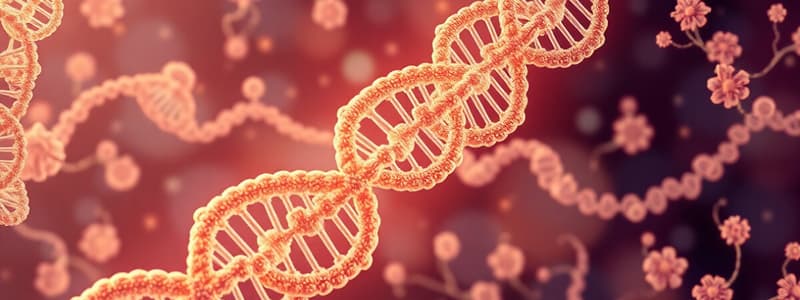Podcast
Questions and Answers
What is the result of adding one phosphate group to a nucleoside?
What is the result of adding one phosphate group to a nucleoside?
- Nucleoside dinucleotide
- Nucleoside triphosphate
- Nucleoside 5'-phosphate (correct)
- Nucleoside adenylic acid
Which components contribute atoms to the purine ring during its synthesis?
Which components contribute atoms to the purine ring during its synthesis?
- Amino acids and carbon dioxide (correct)
- Vitamin C and ribose
- Glucose and phosphates
- Fatty acids and urea
What inhibits the enzyme PRPP synthetase?
What inhibits the enzyme PRPP synthetase?
- Purine nucleotides like GMP and AMP (correct)
- Increased levels of ATP
- High concentrations of ribose 5-phosphate
- Excessive amounts of CO2
What is a common name for the compound adenosine triphosphate?
What is a common name for the compound adenosine triphosphate?
Where is the purine ring primarily constructed in the body?
Where is the purine ring primarily constructed in the body?
Which of the following components are part of a nucleotide's structure?
Which of the following components are part of a nucleotide's structure?
What role do nucleotides play in signal transduction pathways?
What role do nucleotides play in signal transduction pathways?
Which of the following correctly distinguishes purine and pyrimidine bases?
Which of the following correctly distinguishes purine and pyrimidine bases?
What is the significance of nucleotides as 'energy currency' in cells?
What is the significance of nucleotides as 'energy currency' in cells?
What is produced when a pentose sugar is added to a nitrogenous base?
What is produced when a pentose sugar is added to a nitrogenous base?
Flashcards are hidden until you start studying
Study Notes
Nucleotide Structure
- Nucleotides consist of a nitrogenous base, a pentose monosaccharide, and one to three phosphate groups.
- Nitrogenous bases are categorized as purines or pyrimidines.
- Pentose monosaccharides are formed from glucose through the hexose phosphate shunt (HMP shunt).
Nucleotide Function
- Nucleotides are crucial for all cellular processes.
- They serve as building blocks for RNA and DNA.
- Nucleotides act as carriers of activated intermediates in the synthesis of carbohydrates, lipids, and conjugated proteins (e.g., UDP-glucose, CDP-choline).
- They are structural components of essential coenzymes (e.g., coenzyme A, FAD, NAD+, NADP+).
- Some nucleotides act as second messengers in signal transduction pathways (e.g., cAMP, cGMP).
- Nucleotides are the cell's "energy currency" (e.g., ATP).
- They contribute to the regulation of various metabolic pathways by activating or inhibiting key enzymes.
Nitrogenous Bases
- Purines: Adenine (A), Guanine (G)
- Pyrimidines:
- DNA: Cytosine (C), Thymine (T)
- RNA: Cytosine (C), Uracil (U)
Nucleosides
- A pentose sugar added to a base forms a nucleoside.
- Ribonucleoside: Contains ribose sugar.
- Deoxyribonucleoside: Contains 2-deoxyribose sugar.
- Ribonucleosides for A, G, C, and U are: adenosine, guanosine, cytidine, and uridine, respectively.
- Deoxyribonucleosides for A, G, C, and T have the prefix "deoxy-" (e.g., deoxyadenosine).
- Deoxythymidine is often called thymidine.
Nucleotides
- One or more phosphate groups attached to a nucleoside form a nucleotide.
- The first phosphate group is linked to the 5'-OH of the pentose through an ester linkage.
- This forms a nucleoside 5'-phosphate (5'-nucleotide).
- The type of pentose is denoted by the prefix: "5'-ribonucleotide" or "5'-deoxyribonucleotide."
- One phosphate group forms a nucleoside monophosphate (e.g., AMP).
- Two phosphate groups form a nucleoside diphosphate (e.g., ADP).
- Three phosphate groups form a nucleoside triphosphate (e.g., ATP).
- The second and third phosphate groups are connected by "high-energy" bonds.
- Phosphate groups are responsible for the negative charges of nucleotides, leading to DNA and RNA being referred to as "nucleic acids."
Purine Metabolism
- Purine synthesis does not occur as a ring but as a nucleotide.
- Two pathways contribute to purine synthesis:
- De novo synthesis pathway
- Salvage pathway
De novo Synthesis Pathway
- The purine ring is constructed from various compounds including amino acids (aspartic acid, glycine, glutamine), CO2, and N10-formyltetrahydrofolate (derived from folic acid, a B vitamin).
- The purine ring is primarily assembled in the liver.
Synthesis of 5-phosphoribosyl-1-pyrophosphate (PRPP)
- PRPP is an activated pentose involved in purine and pyrimidine synthesis and salvage.
- PRPP synthetase (ribose phosphate pyrophosphokinase) catalyzes the synthesis of PRPP from ATP and ribose 5-phosphate.
- PRPP synthetase is an X-linked enzyme activated by inorganic phosphate.
- It is inhibited by purine nucleotides (GMP, AMP, IMP, allopurinol, 6-mercaptopurine): an example of end-product inhibition.
Studying That Suits You
Use AI to generate personalized quizzes and flashcards to suit your learning preferences.



